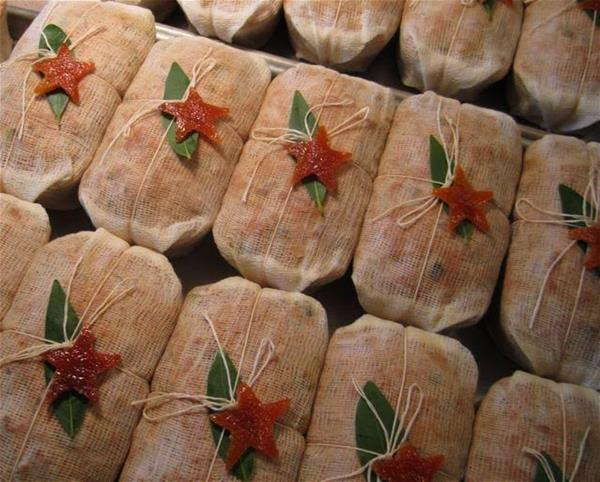The first time you taste Robert Lambert’s rare citrus fruitcake, it’s a revelation. The fruit is bright and sweet and tart. The nuts are deep and rich and toasty. The cake is lightly spiced with just a hint of the cognac it soaked in. It isn’t just good. It is exceptional. So what makes it so different from the legion of mediocre fruitcakes out there?
How did fruitcake get such a bad reputation?
Panforte from Siena. Stollen from Dresden. Panettone from Milan. They’re all fruitcakes of a sort. They come from the same tradition dating back to the middle ages, when ingredients like nuts, fruit, white flour, and sweeteners like honey were in short supply. Back then, combining all of those ingredients into one dessert was the height of luxury. Today, panforte, stollen, and panettone are still much-loved parts of their local holiday traditions.
What about the dense, brick-like fruitcake we all know here in the states? Its downfall starts in the colonial era. With the new supply of sugar from the colonies, fruitcake recipes started getting sweeter—and denser. The sugar acted as a natural preservative, allowing the cakes to be kept longer. It also made for candied fruit with bolder colors and brighter flavors. Then in the Victorian era, somebody came up with the idea of dousing the cakes in booze, making them heavier still and allowing them to keep even longer yet.
That long shelf life led to a new holiday tradition: mailing fruitcakes. However, it seems that right from the start people refused them. Story has it that in 1794 George Washington received a fruitcake in the mail, but he sent it back with a note saying “he thought it unseemly for Presidents to accept gifts weighing more than 80 pounds, even though they were only eight inches in diameter.” A century and a half later, the Apollo 11 astronauts brought fruitcake with them to the moon—and then brought it back to earth uneaten. It’s currently on display at the Smithsonian’s Air & Space museum.
It was the mail order industry that did the fruitcake in (which is ironic for me to say since, ahem, I work for a mail order business). In the 20th century, enterprising bakers realized they could extend that shelf life even longer by adding tons of preservatives, and that they could make the fruit even more brightly colored with dyes. Suddenly fruitcake wasn’t about combining the most luxurious ingredients available. It was about cutting costs and churning out super sweet, super dense cakes as quickly as possible. The jokes started popping up, including Johnny Carson’s famous line: “There is only one fruitcake in the entire world and people keep passing it around.”
Enter Robert Lambert, California’s citrus genius.
Robert makes gorgeous marmalades, jams, syrups and more from fruit grown on his doorstep and by his friends. Once a year for the holidays, he also makes fruitcakes based on his grandmother Floria’s Victorian recipe. He does everything himself. He picks most of the fruit, including exotic citrus like Seville oranges, Rangpur limes, bergamots, blood oranges, and Buddha’s hand citrons. He cuts all of the citrus rinds. He candies all of the fruit. He mixes and bakes the cakes, and then he drenches them in cognac or whiskey. He wraps each cake in cheesecloth by hand. When the word “meticulous” was coined, I think they were thinking of Robert. His recipes are about 15 steps longer than anyone else’s, and his products end up being about 15 times more flavorful. Amazingly, for as complicated as his recipes are, the flavors he produces are pure and clean.
The difference between Robert’s fruitcake and cheap fruitcake is like the difference between a pasture-raised roasted chicken and a pile of chicken nuggets—they hardly belong in the same category. Robert’s fruitcakes are exquisite. They’re intensely flavorful, and each bite is a little different. There’s the bright citrus, the roasty nuts, the warm spices, the kick of the cognac. But for as much as there is going on, the flavors are incredibly well balanced. The cake is best served cool: that way you can slice it thin, so it looks almost like a stained glass window.
Good fruitcakes get better with age. Really.
I promise, I’m not pulling your leg here in a marketing ploy to pass off last year’s cakes that we couldn’t sell. On the contrary, we actually work with Robert a year in advance to make an extra set of cakes to set aside and age. Aging fruitcake is an old tradition. After a feast, a section of the cake would be stashed in a stone crock, packed in powdered sugar, and then kept for a decade or more. (That’s actually where the tradition of holding onto the top layer of a wedding cake for an anniversary comes from—originally, those wedding cakes were fruitcakes.) I think Robert explains it best: “For me the pleasure of the aged cake is the firm, even texture resulting in the ability to cut ever more slender slices, the ripened butter and nut oils and the way the peel flavors mellow and mingle… and isn’t part of that pleasure the romantic notion of the time that has passed since the ingredients were freshly born, and the chance to indulge in that reverie?”

